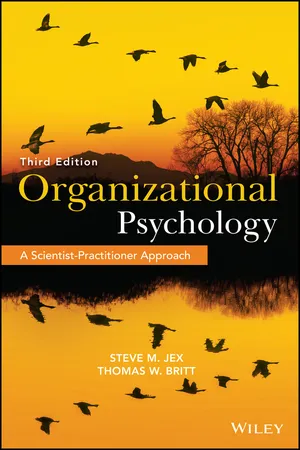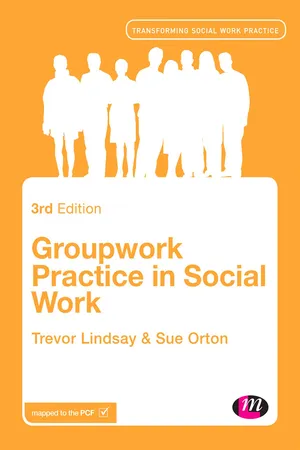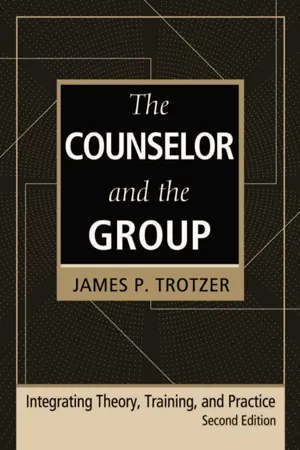Business
Group Development Stages
Group development stages refer to the phases that a team typically goes through as it forms, matures, and accomplishes its goals. These stages often include forming, storming, norming, performing, and adjourning. Understanding these stages can help leaders and team members navigate challenges, build cohesion, and maximize the group's effectiveness.
Written by Perlego with AI-assistance
Related key terms
Related key terms
1 of 4
Related key terms
1 of 3
12 Key excerpts on "Group Development Stages"
- Donald C. Pennington(Author)
- 2014(Publication Date)
- Routledge(Publisher)
performing stage is where the group gets down to the task set and takes the previously agreed upon priorities in order. Groups that are well managed and have clear ideas of how to achieve the task at this stage will have successfully passed through the storming and norming stages. In this stage group members may work alone, in subgroups or with the group as a whole. Mutual interdependence between group members is a key feature of this stage, resulting in co-operation and commitment.The final stage, adjourning, is most likely to occur in specially put together project teams that have been given a set task which, once achieved, results in the group disbanding. Adjourning may also occur because one or more members have left the group and it is unable to continue with the task. A group which has worked well together and become highly cohesive will be difficult for individuals in the group to leave. A formal group which has completed its task may continue informally because of the rewards individual members get from being together.Figure 4.1 summarises these five stages and indicates the key features likely to be present at each stage. Research has provided considerable support for this five-stage model of group development (Eisenstat, 1990). The stage to which a group has developed can be assessed through a questionnaire which focuses on two broad areas: the task in hand and evaluation of the group by the individual members. Task areas include: how well individuals understand the goals of the group; how well the group is organised to achieve the goals; and how well problem-solving takes place. Group evaluation areas include: how much conflict is present; the degree of interdependence between the group members; and how much individuals enjoy being part of the group (Buchan and Huczynski, 1997).FIGURE 4.1- eBook - ePub
Social Groups in Action and Interaction
2nd Edition
- Charles Stangor(Author)
- 2015(Publication Date)
- Routledge(Publisher)
Chapter 8 , members of groups that experience no conflict at all may be unproductive because the members are bored, uninvolved, and unmotivated, and because they do not think creatively or openly about the topics of relevance to them. In order to progress, the group needs to develop new ideas and new approaches, and this requires that the members discuss their different opinions about the decisions that the group needs to make. The approaches the group uses to be creative and productive must be developed through conversation and interaction, which may be accompanied by some conflict.NORMING AND PERFORMINGAssuming that the storming does not go too far, the group will move into a stage in which norms and roles are developed, allowing the group to establish a routine and effectively work together. At this stage the individual group members may report great satisfaction and identification with the group, as well as strong group cohesion. Groups that have reached this stage have the ability to meet goals and survive challenges. However, in some cases the optimal stage for effective performance takes a long time to develop, and groups often do not reach this stage until near the end of the group’s proposed time period.In one interesting observational study studying the group development process, Connie Gersick (1988) observed a number of teams (ranging from student study groups to community fundraising committees) as they worked on different projects. The teams were selected so that, though they were all working within a specific time frame, the time frame itself varied dramatically—from four to 25 meetings held over periods ranging from 11 days to six months. Despite this variability, Gersick found that each of the teams followed a very similar pattern of norming and performing. In each case, the team established well-defined norms regarding its method of attacking its task in its very first meeting. And each team stayed with this approach, with very little deviation, during the first half of the time it had been allotted. However, midway through the time it had been given to complete the project (and regardless of whether that was after two meetings or after 12 meetings), the group suddenly had a meeting in which it decided to change its approach. Then, each of the groups used this new method of performing the task during the rest of its allotted time. It was as if there was a sort of an alarm clock that went off at the halfway point that led each group to rethink its approach. - eBook - ePub
- Michele Kehoe(Author)
- 2013(Publication Date)
- Gill Books(Publisher)
Groups are not static, but dynamic. They form, develop, mature and disband. It is not until a group is mature that it is fully efficient and effective. The four stages of group development were first described in 1965 by Bruce W. Tuckman, a respected educational psychologist. Having examined the behaviour of small groups in a variety of settings, Tuckman identified the distinct phases they go through. He proposed that groups need to experience all four stages of development before they achieve maximum effectiveness. The model was further developed in 1977 in conjunction with May Ann Jensen, and a fifth stage was added.Tuckman and Jensen described the distinct stages that a group experiences as it comes together and starts to operate. This process can occur subconsciously, although an understanding of the stages can be of great benefit to a group in reaching effectiveness more quickly.FormingIndividual behaviour is driven by a desire to be accepted by others and to avoid controversy or conflict. Members share background information about themselves, but serious issues and feelings are avoided. Individuals are gathering information and impressions about each other and about the scope of the task and how to approach it. Even though individuals may experience some anxiety about joining a new group, this is a comfortable stage to be in. If members know each other already, this will be a brief stage. It has also been referred to as the stage of mutual acceptance.StormingAs members get to know one another and are more secure and self-assured, they begin to discuss feelings and opinions openly. Issues for consideration may relate to the work of the group itself or to roles and responsibilities within the group. Some members will be pleased to be getting into the work of the group, while others will long for the comfort and security of the previous stage. This stage is characterised by conflict and may be uncomfortable for some members. Members begin to identify what they want individually and from the group as a whole. The culture of the organisation and individuals will influence the degree to which conflict, and hostility are demonstrated or suppressed. To manage the conflict, individuals will search for structural clarity and rules to prevent the occurrence of ongoing conflict. This stage is also termed the communication stage. - Tony Curtis, John Williams(Authors)
- 2012(Publication Date)
- Routledge(Publisher)
Valuing other types. People feel part of the team and realize that they can achieve work if they accept other viewpoints. Norming is characterized by acceptance. The group needs to establish norms and practices. When and how it should work, how it should take decisions, what type of behaviour, what level of work, and what degree of openness, trust and confidence is appropriate. Whereas in the storming stage, people were apt to rebel very quickly; this is not the case now and if someone has a grievance, complaint or suggestion then the proper processes are used. Goals are understood and roles are clarified. The rules and regulations are being adhered to and people are working together positively. Relationships become stronger as people are more aware of each other.PerformingFlexibility from trust. The team works in an open and trusting atmosphere where flexibility is the key, and hierarchy is of little importance. Not every team makes it to this stage. Many get stuck at norming and although everything appears normal, there is a lack of momentum and motivation towards achieving all the important team goals. At the performing stage, team members are focused on team goals and are aware of the strengths and weaknesses of the team. Only when the three previous stages have been successfully completed, will the group be at full maturity and be able to be fully and sensibly productive.Some kind of performance will be achieved at all stages of the development but it is likely to be impeded by the other processes of growth and by individual agendas. Tuckman’s 5th Stage AdjourningBruce Tuckman refined his theory around 1975 and added a fifth stage to the Forming Storming Norming Performing model – he called it Adjourning, which is also referred to as Deforming and Mourning. Adjourning is arguably more of an adjunct to the original four stage model rather than an extension – it views the group from a perspective beyond the purpose of the first four stages. The Adjourning phase is certainly very relevant to the people in the group and their well-being, but not to the main task of managing and developing a team, which is clearly central to the original four stages.- eBook - ePub
Organizational Psychology
A Scientist-Practitioner Approach
- Steve M. Jex, Thomas W. Britt(Authors)
- 2014(Publication Date)
- Wiley(Publisher)
The stages in this model are presented in Figure 12.1, and reflect the major issues that a team must grapple with at various points in its development. Figure 12.1 Tuckman’s (1965) Model of Group Development As can be seen, the first stage in the model is forming. This is the beginning point in the life of a team and is typically characterized by a great deal of uncertainty, or even anxiety, on the part of team members. This occurs because members of a team may be unfamiliar with each other and may have vastly different expectations about what to expect from membership in the team. At this point in the life of a team, members may deal with such uncertainties by depending heavily on the team leader for information and direction. Ultimately, though, the uncertainties that accompany membership in a new team gradually dissipate over time as team members acquire information and feel more comfortable being part of the team. After issues associated with being in a new team are resolved, the next stage in team development is labeled storming. As one might guess from its name, this stage is characterized by conflict over a number of issues. For example, team members may disagree over important team norms, or perhaps over who should assume leadership responsibilities. This stage may be rather unpleasant, but it is also necessary if the teams hope to ultimately function effectively. If team members never acknowledge their disagreements, these may ultimately come out in subtler ways and prevent the team from ever performing effectively. It should be noted, however, that it is also possible for team members to be too vigorous in airing their differences. If conflicts are too intense and personal, team members may simply be unable to work together and never move past this stage - eBook - ePub
Facilitating with Ease!
Core Skills for Facilitators, Team Leaders and Members, Managers, Consultants, and Trainers
- Ingrid Bens(Author)
- 2017(Publication Date)
- Wiley(Publisher)
Even when a group isn't destined to become a team, it's a good idea to take some tips from rudimentary team building and get members to at least act like a team while they're working together. This can be achieved by incorporating the following key team-building activities right into the agenda. These activities include:- ____ getting people to participate in creating a clear goal for the session or topic being discussed
- ____ creating a set of norms or rules to guide conduct, posting these rules, and encouraging members to use them to maintain effective behaviors
- ____ clarifying roles and responsibilities for all action plans generated by the group
- ____ clarifying all accountabilities to ensure that everyone is clear about expected results
- ____ training members in effective behaviors such as how to handle conflict and make decisions
- ____ conducting process checks, building in feedback loops and other evaluation mechanisms so that members can take responsibility for improving how the group functions
Understanding Team Stages
If you're working with a true team, you need to know that teams develop through four distinct stages. Each of these stages has unique characteristics and must be facilitated differently.Forming—The Honeymoon Stage
Forming is the first stage of team development. It starts when members are first brought together. In the forming stage, members tend to be optimistic, and expectations are usually high. At the same time, there's also anxiety about fitting in and being able to achieve the task. Despite these early anxieties, forming is generally a honeymoon for most teams.Members of forming teams are usually shy. They hold back until they know each other better. People are guarded with their comments. No one is sure exactly how he or she fits into the new team. This stage is also characterized by an overdependence on the leader. Members want to be given a clear mandate, structure, and parameters. - eBook - ePub
- Trevor Lindsay, Sue Orton(Authors)
- 2014(Publication Date)
- Learning Matters(Publisher)
This is perhaps better perceived as a spiral rather than a circle. Tuckman’s (1965) model is perhaps the best-known linear model. He identified a number of distinct stages of development that he designated as forming, storming, norming and performing. To these, others have added a fifth – mourning, to refer to the ending stage. Forming CASE STUDY It is the first session of a group for the parents of school refusers. The facilitator opens with a brief statement setting out the times of meeting and reminding the group that its purpose is to allow members to gain something from the opportunity to meet and share ideas with others who are experiencing a similar problem. This is followed by a long silence, which is broken eventually by two members having an extended discussion about the condition of the school car park. They are interrupted by a third member who talks to the therapist about her child as if no one else is in the room. Finally, one of the first two asks the facilitator what qualifications one needs to run a group like this. Throughout, the other five members stay completely silent. COMMENT None of these responses to the opening stages of a group is unusual. In the beginning stages, individuals may be frightened or nervous, unsure of what is going to happen or of how they are expected to behave. In the first session, you should expect levels of tension to be high. People will react to this tension in many different ways. At this stage the facilitator’s task is to help members feel safe and to come together to form a group that is attractive to them. The first group session is of crucial importance. Look back at Chapter 3 on facilitation and particularly at the section on valuing emotion (see page 53). Remind yourself of the basic human needs to love and be loved, to choose and be chosen, and to understand and be understood - eBook - ePub
The Counselor and the Group, fourth edition
Integrating Theory, Training, and Practice
- James P. Trotzer(Author)
- 2013(Publication Date)
- Routledge(Publisher)
A developmental task is an objective, need, or responsibility that must be addressed in the group in order to insure therapeutic and constructive progress. As these tasks are dealt with effectively, the result is a stronger foundation for group interaction and an achieved readiness to continue the group process through closure. If inappropriately handled or ignored, these tasks can present obstacles that disrupt the group or become the basis for resistance that is detrimental to group development. Thus effective group interaction is contingent upon a structure that considers the developmental tasks as the group moves through its life cycle (Trotzer, 1979, pp. 179-80).The interface between the structuring agents and the developmental tasks creates the actual form of the group and produces the function that the group serves in the lives of its members. The tasks are guideposts to which structural factors can relate in guiding, stimulating, and facilitating the group.The developmental tasks corresponding to each group stage will now be described. Figure 5.1 graphically depicts the relationship among stages and tasks. A brief summary of each stage will precede explication of its developmental tasks (see also Table 4.1 Group Process and Problem Solving, p. 96 and Figure 10.1 Group guidance: Program development format, p. 367).Figure 5.1 Group process: Stages and development tasks.As described in chapters 3 and 4 the group process is composed of five stages that reflect characteristics of our basic human needs, qualities of therapeutic and effective interpersonal relationships, and dynamics of problem solving. Each stage has certain traits that distinguish it, but its meaning and impact are evident only in terms of the total group process. Although leadership style, techniques, group purpose, and membership vary, these stages tend to emerge and evolve as part and parcel of most small group interactions (Trotzer, 1985).Security Stage
The initial stage of the group process is characterized by feelings of discomfort common to forming interpersonal relationships in a new social environment. Group members are reluctant to interact because their presence in the group is contingent on some recognized purpose that requires personal vulnerability or accountability. The purpose of this stage is to develop an atmosphere in which members can relate without hesitancy and where discomfort is alleviated as trust develops. This stage is referred to as the security stage because it must account for each group member’s need for psychological safety and initiate trust which is essential to therapeutic and constructive interaction and necessary for members to disclose personal problems or assets and become meaningful contributors. - Phil Rich(Author)
- 2011(Publication Date)
- Wiley(Publisher)
not pass into the next stage. Instead, groups simply fail to progress at all, remaining stuck in earlier stages where dissatisfaction or lack of focus is most evident, or they disband.Group stage theory is useful because it helps the group clinician visualize the group as a dynamic process, regardless of the specific type of group or its task. In a developmental model, only in an advanced stage of productivity are group members able to work directly on the therapeutic issues that produce and support personal change. High-functioning and mature groups are characterized by their ability to reach and maintain such a stage. In a developmental group model, it is not possible to reach this level without passing through prior developmental stages that build the groundwork for group cohesion and effectiveness. Shown in Figure 23.8 , Lacoursiere's (1980) model of group development describes five stages that synthesize many of the general ideas of group development into a well-defined and useful conceptualization of group life.Figure 23.8 Lacoursiere's (1980) model of group developmental stagesA review of Lacoursiere's five stages shows that although content/task and process/interaction are both always present in group life, the first three stages focus on process rather than task, which cannot be addressed effectively or resolved until group process issues are recognized and resolved. Only in the fourth stage (production) is group work focused more on content than process. Groups must work on their process, or how they get things done, in order to be effective at content, or what gets done. Additionally, not every group reaches the more advanced stage of production, or even resolution.Each time a new member enters the group, the group devolves or returns to an earlier stage of development as it accommodates and adjusts to him or her. Mature (i.e., well-developed and highly functioning) groups are able to assimilate and adjust to new members and quickly return to a higher developmental stage, but nonetheless pass through the stages again. However, as each member shapes the personality and capacity of the group, the group is highly dependent on the contributions of each member. The inability to adjust to new members, pass along group norms, or respond to and address the needs and ideas of new members prevents groups from moving forward. Poor group leadership also will hold a group back; thus it is important that group therapists have a theory of group development and leadership to guide them.- eBook - ePub
Group Work Practice in a Troubled Society
Problems and Opportunities
- Roselle Kurland, Robert Salmon(Authors)
- 2013(Publication Date)
- Routledge(Publisher)
Chapter 10Stages of Development in Women's Groups: A Relational Model
Linda Yael SchillerINTRODUCTION
Groups move through distinct developmental stages as they progress through their life cycle, much as people do. It is important for the student of group work and the group facilitator to have a working understanding of the nature of this developmental course in order to better enhance the growth and change-producing components of the group for its members.This chapter proposes that there is a different model of developmental stages for women's groups than for groups of men, mixed groups, or young children's groups. Drawing on the recent research into women's psychological development by feminist thinkers and the relational model they are proposing, as well as examining the different relationship women have with issues of power, status, and conflict, this chapter proposes that women's groups reflect these differences, and that normative group development for women follows a different course than it does for men. The facilitator who understands particular and unique patterns of growth and development can then intervene more effectively and in a style that best meets the differential needs of the group and its members at each stage of their development. A facilitator may choose a different intervention style for the same problem or dilemma depending on whether the group is in the early, middle, or final stages of its time together, and the facilitator's expectations regarding the development of her group may also affect its progress.REVIEW OF THE “BOSTON MODEL” OF STAGES OF GROUP DEVELOPMENT
For many years one of the primary formulations for charting the developmental course of groups has been the five stages of what has become known as the “Boston Model.” The ground-breaking work of Garland, Jones, and Kolodny (1978) set the tone for years to come, and has become a standard format in which group development has been described. Research cited in their article for the evolution of this conceptual framework is based primarily on the authors’ experiences with facilitating groups of children and adolescents. They describe five stages of development for these groups: pre-affiliation; power and control; intimacy; differentiation; and separation. Each stage has its own dynamic themes, its own inherent issues and struggles, and its own implications for facilitator interventions. - eBook - ePub
- Bradley T. Erford, Bradley T. Erford(Authors)
- 2023(Publication Date)
- Routledge(Publisher)
Change is challenging. For some, the fear of change can make it nearly impossible to move out of a comfort zone. Students in groups come face-to-face with the need for change and their concomitant anxieties and fears. Developmental and systemic theorists propose that the dynamics of control, conflict, and resistance that appear in the transition stage are important steps in the process of change and growth. Like rebellious teenagers testing their wings, members in transition stage groups are testing the group’s ability, and their own abilities, to survive the strain of their real selves. It is up to the group leader to help individuals in the group see how they are resistant to change and how their natural defenses against those things that are fearful and anxiety-provoking alienate them from connection with others and cheat them out of the fullness of life.Passage contains an image
9 The Working Stage
Kevin A. Fall and H. George McMahonDOI: 10.4324/9781003363484-11Preview
For as long as groups have been studied, researchers noted the part in the life of the group where members actively and freely work on group and personal goals, honestly share aspects of self, courageously give feedback, and feel a sense of “we-ness” that enable members to truly believe in the process of group like never before. This chapter provides an overview of the working stage of group work with emphasis on student and leader functions within this important part of the group process. Additionally, components of this stage related to group foundations and design are discussed to illustrate indicators for optimal working-stage process.Overview and Elements of the Working Stage
“So this is the moment I’ve been waiting for?” This quote, uttered by a counseling intern leading their first “real” group, captures the sense of awe and relief felt by leaders and members as they begin to experience the benefits of the working stage of group. As a group successfully navigates its way through the conflicts, role confusion, and general tension that characterize the transition stage, it begins to enter into the working stage. The working stage occurs when group members address the purpose of the group and focus their energies on meeting the individual and group goals articulated during the planning phase and forming and orienting stage. Although group workers have used a variety of terms to describe the stage where the group goals are accomplished, including Performing (Tuckman & Jensen, 1977 ), Action (George & Dustin, 1988 ), Commitment (Berg et al., 2017 ), and Middle stages (Jacobs et al., 2022 ), all describe this working stage as the time when the most significant accomplishments are realized by group members. More important than the amount of time spent in the working stage is what is accomplished during that time. The working stage is where members are expected to derive maximum benefit as members strive to meet group goals and work toward increased personal effectiveness (Berg et al., 2017 - eBook - ePub
- Sam Elbeik, Mark Thomas(Authors)
- 2007(Publication Date)
- Routledge(Publisher)
At some stage the team needs to move on and to do this the project manager must focus his or her efforts on re- establishing a leadership role and restating the aims and objectives of the project itself. Individual roles and responsibilities will also need to be clarified. In effect it requires the project manager to move the team on from a ‘ how’ to a ‘ what we need to do’ perspective.It is important to recognize the storming stage as a perfectly natural phase that teams go through. Despite the unnerving nature that some teams might show when storming, it is a perfectly healthy side to any team’s development. Indeed it is a common characteristic of many failed business teams that they never allowed themselves the right to storm. Such team behaviour is often characterized by subtle game- playing and hidden agendas, whereby everyone knows there is a problem but no one is prepared to confront the real issue.Stage 3: norming
As the necessary storming phase reaches its conclusion most successful teams will begin to embark on the process of norming. A clear sense of purpose, order and sharing starts to emerge. Team members constructively begin to ask for and give opinions to each other. A practical atmosphere of give and take begins to unfold. The acceptance of roles and responsibilities becomes clear. Decisions are taken through reasoned discussion and people get down to the business and tasks in hand.At this stage the role of the project manager is to build on the prevailing atmosphere. Supporting people along with giving and receiving feedback and building a positive working climate become critical activities. As a project manager you may want to discuss how the team is working and generally be prepared to put more management emphasis on asking rather that telling. At this stage teams are also more capable of confronting difficulties. By managing in this way you will find that the various roles and boundaries within the group are more clearly established and maintained. In turn, the unity and solidarity of the team begins to grow. This helps the team prepare for the next phase of development.
Index pages curate the most relevant extracts from our library of academic textbooks. They’ve been created using an in-house natural language model (NLM), each adding context and meaning to key research topics.
Explore more topic indexes
Explore more topic indexes
1 of 6
Explore more topic indexes
1 of 4











